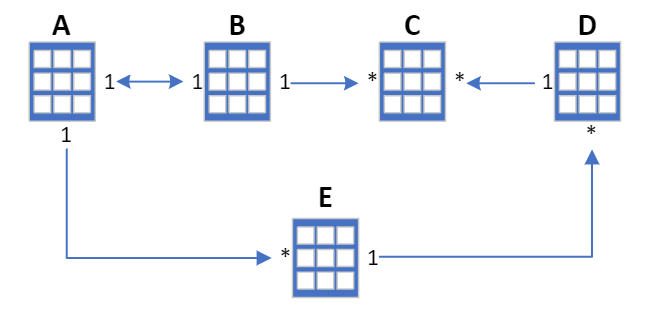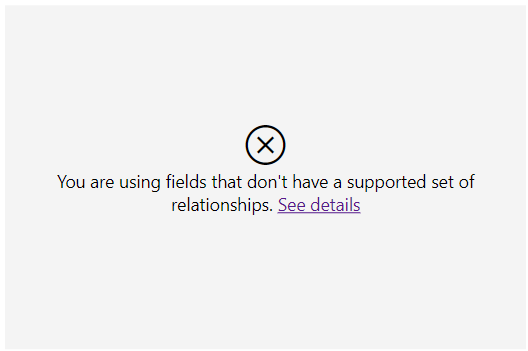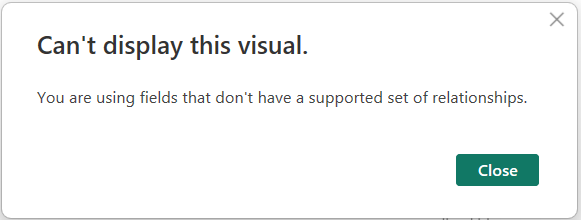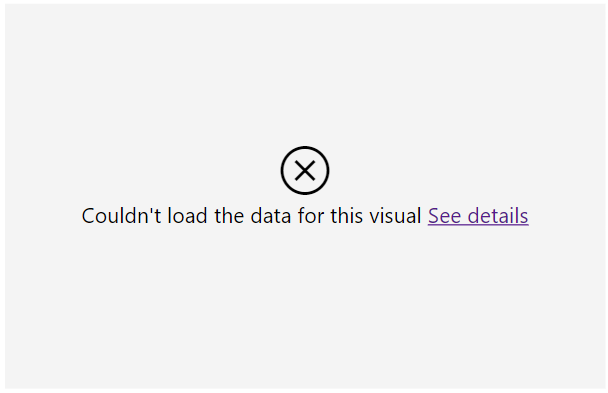The hierarchical identity filters API in Power BI visuals
The Hierarchy Identity filter API enables visuals that use Matrix DataView Mapping to filter data on multiple fields at a time based on data points that use a hierarchy structure.
This API is useful in the following scenarios:
- Filtering hierarchies based on data points
- Custom visuals that use semantic models with group on keys
Note
The Hierarchy Identity filter API is available from API version 5.9.0
The filter interface is shown in the following code:
interface IHierarchyIdentityFilter<IdentityType> extends IFilter {
target: IHierarchyIdentityFilterTarget;
hierarchyData: IHierarchyIdentityFilterNode<IdentityType>[];
}
$schema:
https://powerbi.com/product/schema#hierarchyIdentity(inherited from IFilter)filterType: FilterType.HierarchyIdentity (inherited from IFilter)
target: Array of relevant columns in the query. Currently only a single role is supported; therefore, the target isn't required and should be empty.
hierarchyData: the selected and unselected items in a hierarchy tree where each
IHierarchyIdentityFilterNode<IdentityType>represents a single value selection.
type IHierarchyIdentityFilterTarget = IQueryNameTarget[]
interface IQueryNameTarget {
queryName: string;
}
- queryName: query name of the source column in the query. It comes from the
DataViewMetadataColumn
interface IHierarchyIdentityFilterNode<IdentityType> {
identity: IdentityType;
children?: IHierarchyIdentityFilterNode<IdentityType>[];
operator: HierarchyFilterNodeOperators;
}
identity: The Node identity in DataView. The
IdentityTypeShould beCustomVisualOpaqueIdentitychildren: List of node children relevant to the current selection
operator: The operator for single objects in the tree. The operator can be one of the following three options:
type HierarchyFilterNodeOperators = "Selected" | "NotSelected" | "Inherited";Selected: value is explicitly selected.
NotSelected: value is explicitly not selected.
Inherited: value selection is according to the parent value in the hierarchy, or default if it's the root value.
Keep the following rules in mind when defining your hierarchy identity filter:
- Take the identities from the DataView.
- Each identity path should be a valid path in the DataView.
- Every leaf should have an operator of Selected or NotSelected.
- To compare identities, use the
ICustomVisualsOpaqueUtils.compareCustomVisualOpaqueIdentitiesfunction. - The identities might change following fields changes (for example, adding or removing fields). Power BI assigns the updated identities to the existing filter.hierarchyData.
How to use the Hierarchy identity filter API
The following code is an example of how to use the hierarchy identity filter API in a custom visual:
import { IHierarchyIdentityFilterTarget, IHierarchyIdentityFilterNode, HierarchyIdentityFilter } from "powerbi-models"
const target: IHierarchyIdentityFilterTarget = [];
const hierarchyData: IHierarchyIdentityFilterNode<CustomVisualOpaqueIdentity>[] = [
{
identity: {...},
operator: "Selected",
children: [
{
identity: {...},
operator: "NotSelected"
}
]
},
{
identity: {...},
operator: "Inherited",
children: [
{
identity: {...},
operator: "Selected"
}
]
}
];
const filter = new HierarchyIdentityFilter(target, hierarchyData).toJSON();
To apply the filter, use the applyJsonFilter API call:
this.host.applyJsonFilter(filter, "general", "filter", action);
To restore the active JSON filter, use the jsonFilters property found in the "VisualUpdateOptions":
export interface VisualUpdateOptions extends extensibility.VisualUpdateOptions {
//...
jsonFilters?: IFilter[];
}
Hierarchy related fields validation (optional)
The HierarchyIdnetity filter is supported only for hierarchically related fields. By default, Power BI doesn't validate if the fields are hierarchically related.
To activate hierarchically related validation, add the 'areHierarchicallyRelated' property to the relevant role condition in the capabilities.json file:
"dataViewMappings": [
{
"conditions": [
{
"Rows": {
"min": 1,
"areHierarchicallyRelated": true <------ NEW ------>
},
"Value": {
"min": 0
}
}
],
...
}
]
Fields are hierarchically related if the following conditions are met:
No included relationship edge is many to many cardinality, nor
ConceptualNavigationBehavior.Weak.All fields in the filter exist in the path.
Every relationship in the path has the same direction or bidirectional.
The relationship direction matches the cardinality for one to many or bidirectional.
Example of hierarchy relationships
For example, given the following entity relationship:

- A, B are hierarchically related: true
- B, C are hierarchically related: true
- A, B, C are hierarchically related: true
- A, C, E are hierarchically related: true (A --> E --> C)
- A, B, E are hierarchically related: true (B --> A --> E)
- A, B, C, E are hierarchically related: true (B --> A --> E --> C)
- A, B, C, D are hierarchically related: false (violated rule #3)
- C, D are hierarchically related: true
- B, C, D are hierarchically related: false (violated rule #3)
- A, C, D, E are hierarchically related: false (violated rule #3)
Note
When these validations are enabled, and the fields are not hierarchically related, the visual won't render, and an error message will be displayed:


When these validations are disabled, and the filter visual applies a filter that contains nodes related to non-hierarchically related fields, other visuals might not render properly when measures are in use:


Code example for updating the hierarchy data tree after new selection
The following code shows how to update the hierarchyData tree after new a selection:
type CompareIdentitiesFunc = (id1: CustomVisualOpaqueIdentity, id2: CustomVisualOpaqueIdentity) => boolean;
/**
* Updates the filter tree following a new node selection.
* Prunes irrelevant branches after node insertion/removal if necessary.
* @param path Identities path to the selected node.
* @param treeNodes Array of IHierarchyIdentityFilterNode representing a valid filter tree.
* @param compareIdentities Compare function for CustomVisualOpaqueIdentity to determine equality. Pass the ICustomVisualsOpaqueUtils.compareCustomVisualOpaqueIdentities function.
* @returns A valid filter tree after the update
*/
function updateFilterTreeOnNodeSelection(
path: CustomVisualOpaqueIdentity[],
treeNodes: IHierarchyIdentityFilterNode<CustomVisualOpaqueIdentity>[],
compareIdentities: CompareIdentitiesFunc
): IHierarchyIdentityFilterNode<CustomVisualOpaqueIdentity>[] {
if (!path) return treeNodes;
const root: IHierarchyIdentityFilterNode<CustomVisualOpaqueIdentity> = {
identity: null,
children: treeNodes || [],
operator: 'Inherited',
};
let currentNodesLevel = root.children;
let isClosestSelectedParentSelected = root.operator === 'Selected';
let parents: { node: IHierarchyIdentityFilterNode<CustomVisualOpaqueIdentity>, index: number }[] = [{ node: root, index: -1 }];
let shouldFixTree = false;
path.forEach((identity, level) => {
const index = currentNodesLevel.findIndex((node) => compareIdentities(node.identity, identity));
const isLastNodeInPath = level === path.length - 1
if (index === -1) {
const newNode: IHierarchyIdentityFilterNode<CustomVisualOpaqueIdentity> = {
identity,
children: [],
operator: isLastNodeInPath ? (isClosestSelectedParentSelected ? 'NotSelected' : 'Selected') : 'Inherited',
};
currentNodesLevel.push(newNode);
currentNodesLevel = newNode.children;
if (newNode.operator !== 'Inherited') {
isClosestSelectedParentSelected = newNode.operator === 'Selected';
}
} else {
const currentNode = currentNodesLevel[index];
if (isLastNodeInPath) {
const partial = currentNode.children && currentNode.children.length;
if (partial) {
/**
* The selected node has subtree.
* Therefore, selecting this node should lead to one of the following scenarios:
* 1. The node should have Selected operator and its subtree should be pruned.
* 2. The node and its subtree should be pruned form the tree and the tree should be fixed.
*/
// The subtree should be always pruned.
currentNode.children = [];
if (currentNode.operator === 'NotSelected' || (currentNode.operator === 'Inherited' && isClosestSelectedParentSelected )) {
/**
* 1. The selected node has NotSelected operator.
* 2. The selected node has Inherited operator, and its parent has Slected operator.
* In both cases the node should be pruned from the tree and the tree shoud be fixed.
*/
currentNode.operator = 'Inherited'; // to ensure it will be pruned
parents.push({ node: currentNode, index });
shouldFixTree = true;
} else {
/**
* 1. The selected node has Selected operator.
* 2. The selected node has Inherited operator, but its parent doesn't have Selected operator.
* In both cases the node should stay with Selected operator pruned from the tree and the tree should be fixed.
* Note that, node with Selected oprator and parent with Selector operator is not valid state.
*/
currentNode.operator = 'Selected';
}
} else {
// Leaf node. The node should be pruned from the tree and the tree should be fixed.
currentNode.operator = 'Inherited'; // to ensure it will be pruned
parents.push({ node: currentNode, index });
shouldFixTree = true;
}
} else {
// If it's not the last noded in path we just continue traversing the tree
currentNode.children = currentNode.children || [];
currentNodesLevel = currentNode.children
if (currentNode.operator !== 'Inherited') {
isClosestSelectedParentSelected = currentNode.operator === 'Selected';
// We only care about the closet parent with Selected/NotSelected operator and its children
parents = [];
}
parents.push({ node: currentNode, index });
}
}
});
// Prune brnaches with Inherited leaf
if (shouldFixTree) {
for (let i = parents.length - 1; i >= 1; i--) {
// Normalize to empty array
parents[i].node.children = parents[i].node.children || [];
if (!parents[i].node.children.length && (parents[i].node.operator === 'Inherited')) {
// Remove the node from its parent children array
removeElement(parents[i - 1].node.children, parents[i].index);
} else {
// Node has children or Selected/NotSelected operator
break;
}
}
}
return root.children;
}
/**
* Removes an element from the array without preserving order.
* @param arr - The array from which to remove the element.
* @param index - The index of the element to be removed.
*/
function removeElement(arr: any[], index: number): void {
if (!arr || !arr.length || index < 0 || index >= arr.length) return;
arr[index] = arr[arr.length - 1];
arr.pop();
}
Considerations and limitations
This filter is supported only for matrix dataView mapping.
The visual should contain only one grouping data role.
A visual that uses the Hierarchy identity filter type should apply only a single filter of this type.